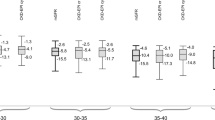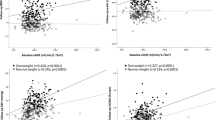Abstract
Obesity has been suggested as a risk factor for chronic kidney disease. However, it has also been suggested that the association between obesity and impaired glomerular filtration rate (GFR) arises from the invalid use of body surface area (BSA) for scaling. This study assesses the effect of obesity on GFR by comparing the age-dependent decline in obese (body mass index (BMI) >30 kg/m2; n=149) and non-obese patients (n=589), aged >30 years, referred for measurement of GFR (Cr-51-EDTA and three blood samples). GFR was scaled to a BSA of 1.73 m2 (GFR/BSA) and extracellular fluid volume of 13 l (GFR/ECV), both corrected for the one-compartment assumption. When non-obese patients were categorized into 10-year age brackets (from 31 to >70), GFR/BSA and GFR/ECV declined from 92 ml per min per 1.73 m2 and 95 ml per min per 13 l, respectively, at 31–40 years to 58 and 59 at >70. The declines in obese patients were similar with corresponding values of 88 ml per min per 1.73 m2 and 97 ml per min per 13 l at 31–40 and 57 and 59 at >70 years. Linear regression analysis of non-categorized data from age 40 years showed rates of decline slightly slower in the obese (0.82 vs 0.95 ml per min per 1.73 m2 per year and 0.87 vs 1.02 ml per min per 13 l per year). No effect of obesity on renal function was shown. Scaling to BSA did not distort the results.
This is a preview of subscription content, access via your institution
Access options
Subscribe to this journal
Receive 12 print issues and online access
$259.00 per year
only $21.58 per issue
Buy this article
- Purchase on Springer Link
- Instant access to full article PDF
Prices may be subject to local taxes which are calculated during checkout

Similar content being viewed by others
References
Hall JE, Henegar JR, Dwyer TM, Liu J, Da Silva AA, Kuo JJ et al. Is obesity a major cause of chronic kidney disease? Adv Ren Replace Ther 2004; 11: 41–54.
Rook M, Bosma RJ, van Son WJ, Hofker HS, Homan van der Heide JJ, Ter Wee PM et al. Nephrectomy elicits impact of age and BMI on renal hemodynamics: lower postdonation reserve capacity in older or overweight kidney donors. Am J Transplant 2008; 8: 2077–2085.
Bosma RJ, van der Heide JJ, Oosterop EJ, de Jong PE, Navis G . Body mass index is associated with altered renal hemodynamics in non-obese healthy subjects. Kidney Int 2004; 65: 259–265.
Chagnac A, Weinstein T, Herman M, Hirsh J, Gafter U, Ori Y . The effects of weight loss on renal function in patients with severe obesity. J Am Soc Nephrol 2003; 14: 1480–1486.
Foster MC, Hwang SJ, Larson MG, Lichtman JH, Parikh NI, Vasan RS et al. Overweight, obesity, and the development of stage 3 CKD: the Framingham heart study. Am J Kidney Dis 2008; 52: 39–48.
Hall JE, Brands MW, Henegar JR . Mechanisms of hypertension and kidney disease in obesity. Ann N Y Acad Sci 1999; 892: 91–107.
Anastasio P, Spitali L, Frangiosa A, Molino D, Stellato D, Cirillo E et al. Glomerular filtration rate in severely overweight normotensive humans. Am J Kidney Dis 2000; 35: 1144–1148.
Schmieder RE, Beil AH, Weihprecht H, Messerli FH . How should renal hemodynamic data be indexed in obesity? J Am Soc Nephrol 1995; 5: 1709–1713.
Grewal GS, Blake GM . Reference data for 51Cr-EDTA measurements of the glomerular filtration rate derived from live kidney donors. Nucl Med Commun 2005; 26: 61–65.
Peters AM . Expressing glomerular filtration rate in terms of extracellular fluid volume. Nephrol Dial Transplant 1992; 7: 205–210.
Fleming JS, Zivanovic MA, Blake GM, Burniston M, Cosgriff PS . British Nuclear Medicine Society. Guidelines for the measurement of glomerular filtration rate using plasma sampling. Nucl Med Commun 2004; 25: 759–769.
Brochner-Mortensen J . A simple method for the determination of glomerular filtration rate. Scand J Clin Lab Invest 1972; 30: 271–274.
Bird NJ, Henderson BL, Lui D, Ballinger JR, Peters AM . Indexing glomerular filtration rate to suit children. J Nucl Med 2003; 44: 1037–1043.
Bird NJ, Peters C, Michell AR, Peters AM . Reproducibilities and responses to food intake of GFR measured with chromium-51-EDTA and iohexol simultaneously and independently in normal subjects. Nephrol Dial Transplant 2008; 23: 1902–1909.
Turner ST, Reilly SL . Fallacy of indexing renal and systemic hemodynamic measurements for body surface area. Am J Physiol 1995; 268: R978–R988.
McCance RA, Widdowson EM . The correct physiological basis on which to compare infant and adult renal function. Lancet 1952; 1: 860–862.
Author information
Authors and Affiliations
Corresponding author
Rights and permissions
About this article
Cite this article
Peters, A., Ciapryna, M., Bowles, P. et al. Obesity does not accelerate the decline in glomerular filtration rate associated with advancing age. Int J Obes 33, 379–381 (2009). https://doi.org/10.1038/ijo.2009.6
Received:
Accepted:
Published:
Issue Date:
DOI: https://doi.org/10.1038/ijo.2009.6



